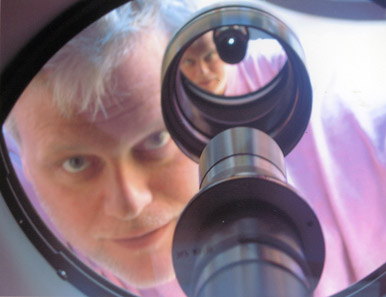Finding a needle in a haystack
BU team identifies new planet orbiting a distant star

The hunt stretched from the summit of a Hawaiian volcano to Europe to a backyard in Maine before an international team of professional and amateur astronomers found their quarry: a new planet orbiting a faraway star.
The planet, dubbed XO-1b, is about 600 light years away, and it orbits a star in the constellation Corona Borealis. The team, which includes Kenneth Janes, a College of Arts and Sciences professor of astronomy, and two BU astronomy doctoral students, Paul Howell (GRS’08) and April Pinnick (GRS’08), estimates that XO-1b is about the size of Jupiter. They believe that it orbits its parent star about once every four days, so tightly that the planet may be as hot as Mercury and therefore an unlikely prospect for life. Scientists believe that the find, which adds one more planet to the 170 discovered in the past decade, will help astronomers better understand solar systems and will aid in the search for other life in the universe.
.jpg)
The search that led to XO-1b was essentially an interstellar process of elimination. It began in September 2003, when team leader Peter McCullough of the Space Telescope Science Institute in Baltimore used a telescope atop the Haleakala volcano in Hawaii to repeatedly scan strips of the night sky over two years, creating time-lapse images of hundreds of thousands of stars. To find a planet in all that data, the astronomers used the “transit method,” looking for stars that dimmed slightly and then brightened again, repeatedly, indicating that a planet might be passing in front of the star in an orbit. But a star might change brightness for many reasons that have nothing to do with an orbiting planet — passing meteors and clouds and two stars orbiting each other, among others. “We’re looking for the proverbial needle in the haystack,” says Janes. “One problem is that we find lots and lots of needles.”
All the image data was processed with software that Janes created with an astronomer at the University of Hawaii, which narrowed the list down to a few hundred possibilities. Another round of culling by computer software at the Space Telescope Science Institute brought it down to a few dozen, which amateur astronomers with ties to the lead researchers tracked, searching for the telltale magnitude and pace of brightness changes that might indicate a lurking planet.
“If it was clear, you’d look at your list and see which of the stars were visible to you, and you’d go observe it,” says Howell, who maintains three computer-directed telescopes in his backyard observatory outside Portland, Maine.
Howell, Pinnick in Arizona, and other amateurs in Belgium and California kept a tag-team watch on the stars, depending on who was favored with a night sky during a star’s transit. One by one, they crossed imposters off their list until they finally locked onto the flicker that would indicate the presence of XO-1b.
“During the night of observation, you’re just collecting data,” explains Howell. “The eureka moment happens when you take that data and you start reducing it and plotting the points, and you see the right shape of the light curve — brightness as a function of time — emerging.”
To double check the amateurs’ observations, the team used one of the largest telescopes in the world, in Texas, to measure what’s known as the Doppler shift, a slight gravity-induced wobble of the star as a planet goes around it. The final bit of confirmation was made by Janes and Pinnick using the Perkins Telescope in Arizona, which BU jointly operates with the Lowell Observatory. An account of the discovery will appear in the September issue of Astrophysical Journal.
The transit method can detect only very large planets in very tight orbits around stars, so-called “hot Jupiters,” which are unlikely to support life. Nevertheless, says Janes, the discovery and follow-up studies of XO-1b will help astronomers understand more about solar systems in general, including what characteristics are particular to our own life-bearing solar system.
The study also has revealed the effectiveness of using amateur astronomers in the hunt for new planets. “There are a lot of amateurs sitting out there with all this latent ability,” says Howell. “All it takes is for someone to put it to work.”
As for XO-1b, the team has booked time on the Hubble and Spitzer space telescopes to make the deep-space observations that could tell them more precisely how distant the planet is from Earth and what it’s made of. And, says Janes, there’s still a lot of data from the two years of night scans to mine. “We don’t have any other live prospects,” he says. “But we still have the expectation of more discovery.”